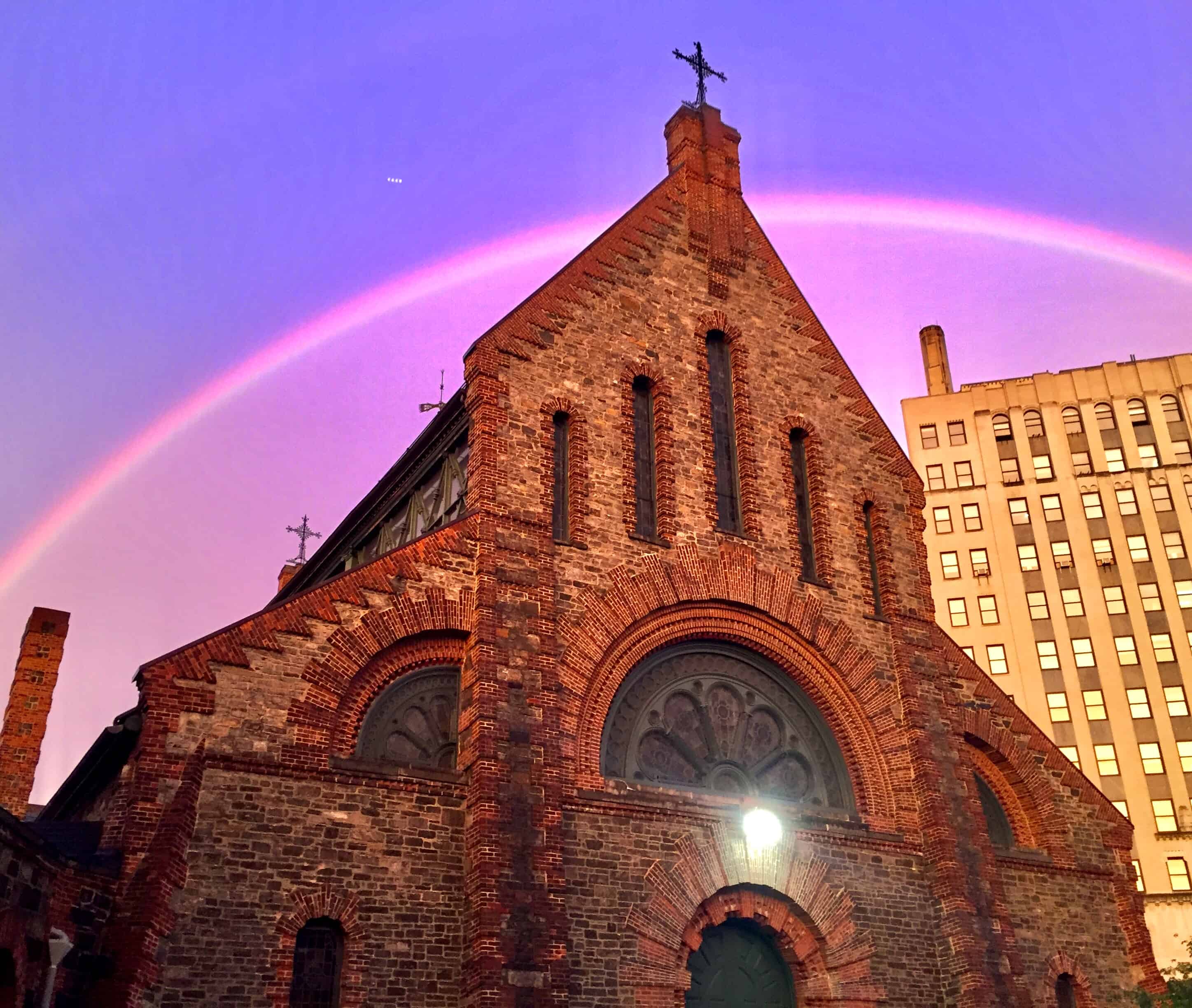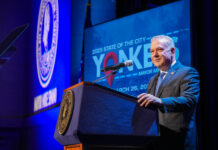
By Angelique Piwinski
Yonkers Historian
On Sunday September 23rd,
St. John’s Episcopal Church Getty Square will celebrate its 325th anniversary Sunday, Sept. 23. The public is invited to a Festival Holy Eucharist at 10:15 a.m., an historic tour of the church at noon and a gala luncheon at 1 p.m. at The Riverview. The luncheon will help support a fundraising effort to restore the Clerestory Windows in the church’s 1872 building.
The last opportunity to purchase tickets will be Sept. 17. Tickets can be obtained by calling 914-963-3033.
In September 1693, the church was included in an act during the first session of the Third Assembly, in the fifth year of the reign of King William III and Queen Mary II, joint monarchs of England, Scotland and Ireland, 83 years before the Declaration of Independence. Mentions of the Yonkers congregation, however, date as early as 1684.
The first church building was erected in 1752 by Fredrick Philipse III, the owner of Philipse Manor Hall and 52,000 acres from Spuyten Duyvil to the Croton River. This first church in Yonkers has witnessed the entire history of the United States and the Town, Village and then City of Yonkers. Entering this historic building, much of it can be seen in the artifacts and stained-glass windows.
The original south wall and main doors are preserved. During the American Revolution, wounded from both sides were carried through them as the church served as a neutral hospital. Because of this, St. John’s enjoys a unique status as both an important religious and military institution. It is also the only church to have a charter from New York State.
The lands of Frederick Philipse III and his Manor of Philipsburgh, including the church, were confiscated in 1785, because Philipse sided with the British. However, by acts of the New York State Legislature in 1786 and 1792, New York State gave the church and 2 acres back to the Episcopal Church by charter forever.
Because of membership growth over the years the church expanded several times, the last of which was in 1872. With each expansion, however, the goal had been to preserve as much of the original church edifice as possible.
Saint John’s is the oldest stone Episcopal Church in New York State.
St. John’s is also home to one of the most historic bells in America with direct ties to Paul Revere, Abraham Lincoln and more. It has been home for 200 years to a bronze bell cast in 1808 by America’s first recognized bronze bell maker, Col. Benjamin Hanks. This bell is believed to be the last remaining bell from Hank’s Mansfield Connecticut foundry that operated from 1790 until 1808. It has pealed on every occasion of marriage, funeral and celebration in Yonkers and has marked the end of every war for 200 years.
The bell’s ringing mechanism broke several years ago, and the 900-pound bell was frozen in a precarious 45-degree angle, placing stress on the almost 150-year-old bell tower and deteriorating the bell. In order to ring again, the bell and its ringing mechanism needed to be removed and restored.
Late last year, The Vestry of St. John’s voted to remove and restore it. The only method of restoration was to send it to Holland to have a piece of it repaired and recast. This work was completed, and the bell was returned to Saint John’s on April 24.
This bell has a grand history. Col. Benjamin Hanks cast the bell in his foundry in 1808. Born in Mansfield, Conn., in 1755, Benjamin Hanks served as a drummer during the American Revolution and took part in the march to Lexington in response to Paul Revere’s alarm, and later was a drummer with Gen. Israel Putnam’s Third Connecticut Regiment. He worked as an apprentice to Thomas Harland, a noted Norwich, Conn., clockmaker, and he is said to have spent time working in a foundry owned by Paul Revere. Around 1780, he established a bell and cannon foundry in Mansfield that made the bell that was installed in St. John’s bell tower in 1818.
This was the first bell ever to ring in Yonkers. In 1820, the Yonkers population was only 1,500 people. Saint John’s Episcopal Church, part of the Episcopal Diocese of New York, welcomes the community to join in celebrating the rich history in Getty Square, Yonkers. For more information, email parish@yonkerschurch.org or call 914-963-3033.
Editor’s Notes:
St. John’s Episcopal Church in Yonkers is the second oldest church in Westchester County. The oldest church in Westchester County is The Old Dutch Church of Sleepy Hollow, which was also built by a member of the Philipse family.
Frederick Philipse I, Lord of Philipse Manor, owned the vast stretch of land spanning from Spuyten Duyvil in the Bronx to the Croton River. After swearing allegiance and later being granted his Manorship from the English, he chose to establish his country seat at what was then known as north Tarrytown, where the Pocantico River flowed into the Hudson River.
Philipse’s wife died in 1691, and he soon remarried. His second wife, Catharine Van Cortlandt Derval, urged him to build a more permanent stone church for his tenants, and later in the decade he obliged her, being its architect, financier, and aid in its construction. A marble tablet in front of the church gives its completion date as 1699. The tablet was placed in the 19th century, however, and it is seen as more likely that the church was finished by 1697.
In 1685, when it was built in the wilderness north of New York City, the Old Dutch Church of Sleepy Hollow brought comfort and community to isolated pioneer families. Succeeding generations treasured the old church, the only house of worship in a wide area until 1837, when members of Old Dutch built a larger church nearby then another a few years later. Yet somehow they didn’t abandon the old church, which continues to this day to host the congregation every summer for worship services.
What was it about the church on the Pocantico River, made famous by Washington Irving’s Legend of Sleepy Hollow?
“It stands on a knoll, surrounded by locust-trees and lofty elms, from among which its descent, whitewashed walls shine modestly forth, like Christian purity, beaming through the shades of retirement… To look upon this grass-grown yard, where the sunbeams seem to sleep so quietly, one would think that there, at least the dead might rest in peace,” wrote Irving in “The Legend of Sleepy Hollow.”
When Washington Irving set his ghost story about the Headless Horseman at the Old Dutch Church of Sleepy Hollow, he made the church world-famous. Ever since the publication of “The Legend of Sleepy Hollow” in 1819-20, visitors have come to see where Ichabod Crane led the choir and courted Katrina Van Tassel among the old gravestones in the churchyard, and looked for the grave of the Headless Horseman in the Old Burying Ground.
The church is recognized as the oldest extant church in New York and a national historic landmark. The Old Dutch burying ground, which surrounds it on three acres, is believed to predate the church. Irving is buried just up the hill, in the Sleepy Hollow Cemetery adjacent.
Other events at Old Dutch include Christmas Eve candlelight services, organ concerts and the Old Dutch Festival in the fall. Tours are scheduled on summer weekend afternoons. The Reformed Church partners with Historic Hudson Valley to present several dramatic readings of “The Legend of Sleepy Hollow” in the fall, and Charles Dickens’ “Christmas Carol.”
For more information, visit reformedchurchtarrytowns.org or historichudsonvalley.org.





